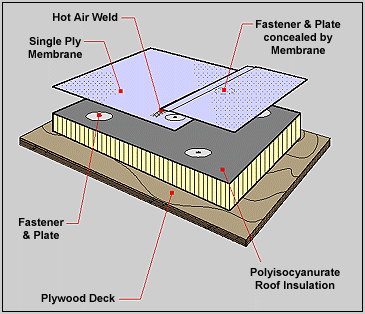
flat & low slope roofing
With most commercial roofs now being flat or low-slope, many kinds of materials can now be chosen based on the application with warranteed life expectancy ranging from 10-30 years. Below is an outline of the two major versions and their respective types of material:
Bituminous Roofing Membranes
Built-Up or Modified Bitumen both involve assembling sheets of overlapping asphalt impregnated felt layers between layers of liquid-applied hot asphalt to form a relatively thick and durable roofing membrane. Account for approximately 40% of the low-slope roofing membranes, with most of this portion being Modified Bitumin.
Built Up Roof – Oldest form of Bituminous Roofing membranes. Lapped asphalt-impregnated (cellulose, glass, or synthetic) felt sheets and liquid asphalt product adhere to eachother to forma durable, multi-ply roofing layer. Base sheet, ply sheet/s, and a specialized/coated cap sheet are utilized in pre-manufactured rolls. Also liquid-applied final cap layer is often utilized. Can be used on inclines up to 9 inches per foot. Ply felts are typically 15-30lb rolls per square and 36″ wide, 432 or 216sf.



Modified Bituminous Roof – Made from manufactured plastic, glass-fiber, or fibrous reinforced (0.04-0.16″) sheets of Polymer-Modified bitumens.These modified bitumens are most commonly APP (atactic-polypropylene) or SBS (styrene-butadiene-styrene) which increase cohesion, durability, and flexibility. SHeets are bonded by torch, hot-mopped, cold adhesive, or self-adhered. Top sheet or cap-sheet is surfaced with mineral granules, metallic laminates, or asphaltic/elastomeric coating for UV/wear/fire resistance.Provide the strength and durability of Built-Up-Rooofing with the convenience and efficiency of pre-manufactured, single-ply high-quality sheets. Account for 20-30% of all low-sloped roofing systems. Life and warranty depend on the number of layers and can vary between 10-20 years.

Single Ply Roof Membranes
Constantly evolving single-layer sheet material, more elastic than bituminous, less prone to cracking/tearing over time, membrane thicknesses from 0.035 to 0.12 inches. Can be:
Fully adhered



Mechanically Fastened - Pentetrating or Non-penetrating

Non-Penetrating Fasteners

Completed Roof with Pentrating fasteners and lapped joints
Ballasted

Fully adhered roofs when installed properly last 15-20 years on average, with some EPDM roofs able to reach 30 years. Mechanically fastened roofs will last 10-15 years on average. Less on-site labor than bituminous. Can be thermosetting (or elastomerics): not heat-setting and are joined at seams by adhesive or tape. Or thermoplastic (heat-softened). Thermosetting seams are known to be less reliable than thermoplastic.
EPDM (Ethylene-Propylene-Diene-Monomer)


Most common thermosetting (heat-softened) roof material and been in use for approximately 40 years with arguably the longest average service life. A synthetic rubber with or without fiber reinforcing, ozone/heat/UV/weather resistant, and available in black or white sheets. Can’t be heat-welded, seams adhered with tape or adhesive. Arguably the most widely used material for low slope roofing and accounting for approximately 1/3 of the market. Available sheet thicknesses of 45 or 60 mils. Fully adhered, mechanically fastened, or ballasted. Can last up to 30 years depending on sheet thickness and installation.

PVC (Polyvinyl Chloride) - Made of PVC resin/plasticizer/stabilizers/fiber/fabric, highly-recyclable, with excellent water permeability resistance. Mechanically fastened or fully adhered, thicknesses ranging from 50-80 mils. Lightweight (45mils typically 0.25lbs/sf) Between PVC and TPO, 20% of low-sloping roofs are accounted for. Forced hot-air utilized to seal seams. Commonly a 1/4″ fiberglass sheathing substrate.

TPO (Thermoplastic-Polyolefin) - Newer low-slope roofing material made from polyethylene/ethylene-propylene rubber polymers reinforced with fabrics or fibers. Because of thermoplastic nature, seams can be heat-welded. Good UV/heat resistance. May be more economical than PVC but with a shorter warranty of often 10-15 for a standard system.



Seaming Equipment

Fluid-Applied Roof Membranes are also available which are used mostly for domes or other complicated roof shapes where materials can be applied by roll or spray application. These materials are neoprene, silicone, polyurethane, butyl rubber, or asphalt emulsion. These systems are good when tear off isn’t budgeted or necessary, or when a building owner simply wants to attain 5-15 more years of roof use before full replacement.


It should be pointed out that a cold-applied asphalt roofing system (because of the extended cure times) creates a significant mess which requires excessive protection and can run the risk of tracking material around the property for even weeks after completion of the product. It should also be mentioned that when a hot-mopped asphalt roof system will be applied on or near an existing building, it is important that any rooftop air-handler units will need to be shut down to avoid drawing the odors into the building. For this reason, this type of work is popularly done on nights or weekends.
A watertight roof is one of the most important milestones on a construction job as once this is achieved, much of the interior work can commence (insulation, drywall, ducts, acoustical ceilings). The roof will be installed as early as possible on a construction project, thus protection and even repair allowances must be the responsibility of the general contractor and all trades working on the project. Minor damage is almost inevitable during the construction process. Finding leaks can be very difficult and they are most commonly a result of damage done by other trades.
To help prevent and reduce damage, walk pads are installed in strategic locations on flat roofs, to allow construct and later maintenance traffic passage to and from rooftop equipment and other features.


